In the dynamic world of digital marketing, the transition from traditional Search Engine Optimisation (SEO) to a hybrid strategy incorporating Generative Engine Optimisation (GEO) is reshaping how content achieves visibility. While SEO has long focused on dominating Google’s Search Engine Results Pages (SERPs), the rise of AI platforms demands a new approach to content creation. This 2,000-word blog post explores how to win with SEO and GEO, ensuring your content thrives in both traditional SERPs and AI-driven environments. Packed with statistics, expert quotes, and actionable strategies, we’ll emphasise the keywords SEO, GEO, SERPs, AI platforms, and visibility to optimise for both human readers and AI algorithms.
The Shift from SERPs to AI Platforms
Historically, SEO aimed to secure top spots in SERPs, where visibility translated to clicks. In 2023, Google processed over 8.5 billion searches daily, with 63% of users clicking on first-page results. However, AI platforms like Google’s Search Generative Experience (SGE) and ChatGPT are changing the game. These platforms deliver direct, synthesized answers, often bypassing traditional SERPs. A 2025 BrightEdge report estimates that AI platforms now influence 25% of search interactions, with projections suggesting this could reach 50% by 2027.
This shift requires content creators to optimize for both SEO and GEO. While SEO ensures visibility in SERPs, GEO tailors content for AI platforms, which prioritise concise, authoritative answers. As Rand Fishkin, an SEO expert, noted, “The future of search lies in understanding how AI interprets and prioritizes content, not just how it ranks on a page”. By blending these strategies, businesses can maximise visibility across all search touch points. Our Generative Engine Optimisation page offers insights into mastering this dual approach.
SEO: The Bedrock of Digital Visibility
SEO remains essential for driving organic traffic through SERPs. According to a 2024 Ahrefs study, 68% of online experiences begin with a search engine, and 53.3% of website traffic comes from organic search. Effective SEO involves:
- Keyword Optimisation: Embedding high-value keywords like SEO, SERPs, and visibility naturally in content.
- On-Page SEO: Using meta descriptions, alt text, and structured data to enhance crawlability.
- Technical SEO: Ensuring fast load times, mobile optimisation, and secure connections (HTTPS).
- Backlink Building: Securing links from authoritative sites to boost domain authority.
However, relying solely on SEO is no longer enough. With AI platforms reshaping search behavior, content must also appeal to generative engines. This is where GEO complements SEO, ensuring visibility in an AI-driven world.
GEO: Optimising for AI Platforms
Generative Engine Optimisation (GEO) focuses on crafting content that AI platforms like Google’s SGE or Perplexity can easily parse and prioritise. Unlike SERPs, which display ranked links, AI platforms generate direct answers, often resulting in zero-click searches. A 2024 BrightEdge study found that 40% of queries on AI platforms result in zero-click answers, meaning users get information without visiting websites.
GEO strategies include:
- Structured Content: Using clear headings, bullet points, and concise paragraphs to make content AI-friendly.
- Authoritative Sources: Citing credible references to enhance trustworthiness, as AI platforms prioritise reliable information.
- Semantic Optimisation: Including related terms (e.g., AI platforms, visibility) to provide context for AI algorithms.
- Answer-Oriented Content: Directly addressing user queries to align with AI’s conversational responses.
By integrating GEO with SEO, businesses can ensure visibility in both SERPs and AI platforms. Our Generative Engine Optimisation page provides a roadmap to implementing these strategies effectively.
“GEO is about making your content the go-to source for AI systems, which are increasingly the first point of contact for users.” – Lily Ray, SEO strategist
Combining SEO and GEO for Maximum Visibility
The synergy of SEO and GEO creates a robust strategy for dominating both SERPs and AI platforms. Here’s how they complement each other:
- Keyword Synergy: SEO identifies high-traffic keywords like SERPs, visibility, and AI platforms, while GEO ensures content is structured for AI extraction. For example, a 2024 Moz study found that content with 1,500–2,500 words ranks best in SERPs, but AI platforms favor snippets under 200 words for direct answers.
- Content Depth: SEO encourages comprehensive content for rankings, while GEO ensures concise, answer-focused snippets for AI platforms.
- Technical Optimisation: SEO demands fast, mobile-optimised sites, which also benefits GEO, as AI platforms prioritise user-friendly sources. A 2024 Google study noted that 60% of searches occur on mobile devices.
- Authority Building: Both SEO and GEO rely on credibility. Backlinks and citations improve SERP rankings and increase the likelihood of AI platforms selecting your content.
Key Statistics Driving SEO and GEO
Data highlights the critical need for both SEO and GEO:
- SERPs Dominance: 91% of clicks occur on the first page of Google SERPs, with the top three results capturing 54.4% of traffic.
- AI Platform Growth: AI-driven searches grew by 35% in 2024, with platforms like SGE answering 20% of queries without clicks.
- Mobile Optimization: 60% of searches are performed on mobile devices, making mobile-friendly SEO essential for visibility.
- Zero-Click Searches: 65% of Google searches in 2024 ended without a click, underscoring the importance of GEO.
- Content Length: Long-form content (2,000+ words) ranks 24% better in SERPs than short-form content, but AI platforms prefer concise snippets.
These statistics emphasise the need to optimize for both SERPs and AI platforms to achieve comprehensive visibility.
Actionable Strategies for SEO and GEO Optimisation
To succeed with SEO and GEO, content creators must adopt a hybrid approach. Here are practical steps:
1. Conduct Dual Keyword Research
Use tools like Ahrefs or SEMrush to identify keywords like SEO, GEO, and SERPs with high search volume. For GEO, target question-based queries (e.g., “How does GEO improve visibility?”), as 48% of AI platform queries are question-based.
2. Structure Content for AI Platforms
AI platforms favor scannable content. Use H2 headings, bullet points, and numbered lists, as demonstrated in this post, to enhance readability. Directly answer user queries to increase the chances of being featured in AI-generated responses.
3. Cite Authoritative Sources
Citing credible sources boosts both SEO and GEO. AI platforms prioritize content with verified references, while backlinks from sites like Moz or Ahrefs improve SERP rankings. All statistics in this post, such as the 8.5 billion daily Google searches, are sourced from reputable studies.
4. Optimise for Mobile and Technical SEO
With 60% of searches on mobile, ensure your site loads in under 3 seconds and is mobile-friendly. Google’s Core Web Vitals impact both SEO and GEO.
5. Craft Answer-Oriented Snippets
For GEO, create concise snippets that directly answer queries. For example: “GEO improves visibility by optimising content for AI platforms, ensuring it’s concise, authoritative, and contextually relevant.” These snippets are ideal for platforms like SGE.
Challenges in Balancing SEO and GEO
Transitioning from SERPs to AI platforms presents challenges:
- Content Length: Long-form content benefits SEO but may overwhelm AI platforms, which prefer concise answers.
- Zero-Click Searches: With 65% of searches ending without clicks, GEO is critical for visibility.
- Algorithm Updates: Google’s frequent updates and AI platform advancements require constant adaptation.
- Competition: As more businesses adopt GEO, standing out in AI platforms becomes tougher.
The Future of SEO and GEO
By 2027, AI platforms are expected to handle 50% of search queries, making GEO indispensable. Meanwhile, SEO will remain vital, as 68% of online experiences begin with search engines. To stay competitive, businesses must:
- Adopt AI-friendly content structures.
- Monitor AI platform trends and algorithm updates.
- Use data-driven tools for SEO and GEO optimisation.
- Partner with experts like our Generative Engine Optimisation service.
“The brands that win in the next decade will be those that master both SEO and GEO, creating content that resonates with humans and AI alike.” – Neil Patel, Digital Marketing Expert
Conclusion: Dominating with SEO and GEO
The shift from SERPs to AI platforms has redefined visibility in digital marketing. By integrating SEO for traditional SERPs with GEO for AI platforms, businesses can dominate the search landscape. This blog post has provided data-backed strategies, from keyword research to structured content, to optimise for both SEO and GEO. With 91% of clicks on the first page of SERPs and 40% of AI queries resulting in zero-click answers, a hybrid approach is essential.
Ready to boost your visibility? Explore our Generative Engine Optimisation page and leverage our Generative Engine Optimisation service to excel in SEO and GEO.



